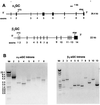Genomic organization of alpha1 and beta1 subunits of the mammalian soluble guanylyl cyclase genes
- PMID: 10984516
- PMCID: PMC27117
- DOI: 10.1073/pnas.190331697
Genomic organization of alpha1 and beta1 subunits of the mammalian soluble guanylyl cyclase genes
Abstract
The structures of the genes encoding the alpha(1) and beta(1) subunits of murine soluble guanylyl cyclase (sGC) were determined. Full-length cDNAs isolated from mouse lungs encoding the alpha(1) (2.5 kb) and beta(1) (3.3 kb) subunits are presented in this report. The alpha(1) sGC gene is approximately 26.4 kb and contains nine exons, whereas the beta(1) sGC gene spans 22 kb and consists of 14 exons. The positions of exon/intron boundaries and the sizes of introns for both genes are described. Comparison of mouse genomic organization with the Human Genome Database predicted the exon/intron boundaries of the human genes and revealed that human and mouse alpha1 and beta1 sGC genes have similar structures. Both mouse genes are localized on the third chromosome, band 3E3-F1, and are separated by a fragment that is 2% of the chromosomal length. The 5' untranscribed regions of alpha(1) and beta(1) subunit genes were subcloned into luciferase reporter constructs, and the functional analysis of promoter activity was performed in murine neuroblastoma N1E-115 cells. Our results indicate that the 5' untranscribed regions for both genes possess independent promoter activities and, together with the data on chromosomal localization, suggest independent regulation of both genes.
Figures



References
Publication types
MeSH terms
Substances
Associated data
- Actions
- Actions
LinkOut - more resources
Full Text Sources
Other Literature Sources
Molecular Biology Databases

